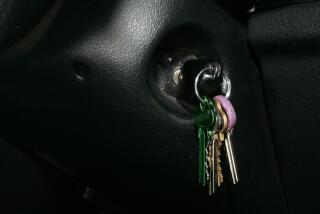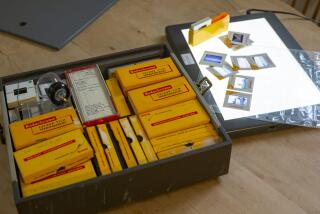Brain of famous amnesiac “H.M.” yields new insights into memory

Scientists use a machine to dissect one of the most famous brains in the history of neuroscience. It belonged to Henry G. Molaison, known to the world as “H.M.”
If you know that a small seahorse-shaped structure deep in the brain -- the hippocampus -- is crucial to committing new facts and skills to memory, you have not only your hippocampus to thank; you also owe a debt of gratitude to Henry Gustav Molaison, known to brain scientists worldwide as the amnesic patient “H.M.”
A new study shows that in death as in life, the man who lived 55 years virtually unable to form new memories deepened our understanding of what it takes to make them.
More specifically, it clearly shows that after surgery to remove H.M.’s hippocampus and surrounding tissue as a treatment for epilepsy in 1953, portions of the structure remained in both hemispheres of his brain.
Until recently -- when their presence was detected by magnetic resonance imaging -- no remnants were thought to have existed. H.M.’s surgical lesions, along with his profound memory impairment after the surgery, have been crucial in characterizing the role of the hippocampus and its surrounding structures as key to the consolidation and storage of “declarative memory,” or memory that is consciously learned and retrieved.
H.M.’s lifetime as a research subject helped refine neuroscientists’ understanding of memory as a complex and multilayered phenomenon served by many regions of the brain.
After he had the surgery at age 27, Molaison’s language and perceptual skills remained intact; he could remember general aspects -- though not specific events -- of his life before the surgery, and could learn new motor and mechanical skills.
But he was almost completely unable to retain memories of events that occurred, or people he met, after the surgery. And despite the fact that he could improve a new skill when trained to do so, he was incapable of recalling that he had ever been taught that skill.
PHOTOS: Studying the brain of “H.M.”
Until his death at 82, Molaison lived in a state of “permanent present tense” -- the title of a book on his life and contributions to brain science written by MIT neuroscientist Suzanne Corkin, a coauthor of the current study.
The remnants of H.M.’s hippocampus and some of the surrounding tissue unexpectedly spared by Dr. William Beecher Scoville can now be seen and studied in high-resolution, three dimensional images of H.M.’s entire brain, which has resided since 2008 at a neuroanatomy laboratory at UC San Diego.
The new images, created and analyzed by a team led by neuroanatomist Jacopo Annese, were released Tuesday and published in the journal Nature Communications. They will now become available to neuroscientists.
The early findings from that effort are notable for their consistency with previous imaging studies, said Brenda Milner, professor of neurosurgery at McGill University’s Montreal Neurological Institute. “That’s reassuring,” said Milner, who was the first researcher to study H.M. She was not involved with the latest effort.
Echoing Annese, Milner said it was possible that the bits of hippocampus left behind by Scoville may have helped H.M. develop vague postsurgery memories of people and events he had seen repeatedly on television, including the 1969 moon landing, the assassination of John F. Kennedy and the singer Liza Minelli.
Corkin, however, expressed doubt that the remnants of hippocampus were functional after the surgery. Having been robbed of incoming signals by the removal of the adjoining entorhinal cortex, the observed remains appeared to have atrophied.
More likely, said Corkin, other parts of H.M.’s brain that were untouched by the surgery, including his entire cerebral cortex, may have afforded him some semblance of recall despite his profound amnesia.
VIDEO: Cutting open a famous brain
After Molaison’s death in 2008, the famous amnesiac’s brain was removed and bathed in formalin. After two months, it was soaked in sucrose and glycerol to prevent shrinkage, wrapped in cotton, and transported to Annese’s lab in San Diego. There, it was encased in gelatin and frozen.
In a continuous 53-hour procedure that was tweeted and webcast from Annese’s lab, H.M.’s brain was surgically sliced into 2,401 cross-sections stretching from front to rear. The slices were photographed and digitized, resulting in the creation of a high-resolution, three-dimensional model that will let future researchers conduct a “virtual dissection” of the organ, which was made famous by a 1957 article that is among the most cited in all of medical literature.
Annese said he had met the famous patient just once. Molaison was 80 and, having suffered several strokes, was no longer able to carry on a conversation. Annese said he would ask the patient, if he could, whether he understood how much he had helped to advance neuroscience. And, he said, he would would ask if he was pleased with Annese’s work.
Corkin, who studied H.M. for 46 years, will chair a panel to oversee future research on his brain, using the three-dimensional slides. Corkin said the new images will help researchers explore, among other mysteries, the neurological basis for different kinds of memory -- including those that shape our identities, allow us to learn new skills, interact socially and plan for the future.
“A lot of rich science will flow from this in the future,” she said. The current paper’s message, she added, is to “stay tuned for the hard-core science to follow.”
The slides may also shed light on epilepsy -- erratic and often disabling electrical storms in the brain. Though the disease is largely treated with medications, unresponsive cases are sometimes treated with modern-day versions of Scoville’s surgery.
Corkin said the new slides may reveal a darker possibility: that the surgery that robbed H.M. of his ability to form new declarative memories -- but which partially ended his seizures -- should never have been done. Scientists will likely comb the newly available images to pinpoint where in the brain H.M.’s seizures began.
At the time of the surgery, Scoville acknowledged that electrodes sunk into H.M.’s brain failed to identify the hippocampus or temporal lobes as the origins of his errant bursts of electrical activity. That the seizures stopped after surgery suggests that the procedure somehow broke the chain of misfiring electrical signals anyway -- but at a steep cost.
If researchers find that H.M.’s epilepsy was isolated to other parts of his brain, they may show that the surgery that cost H.M. his identity need never have been done, Corkin said.
[For the record, 8:23 p.m. Jan. 31: An earlier version of this post referred to the 1968 moon landing. The first moon landing was in 1969.]







